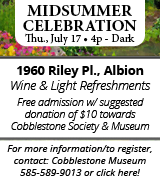Nature is reclaiming the Trestle

Photos by Tom Rivers – Vines have wrapped around one of the stone pillars that used to hold up the trestle in Waterport.

Fishermen stand next to the stone bases from the trestle while trying to catch Chinook salmon.
WATERPORT – The massive stone bases that once held up the Waterport Trestle are still visible 20 years after the trestle was dismantled.
But nature is on the offensive, as vines, poison ivy, and trees have migrated to the stone pillars and, in some cases, wrapped around them.
The woods and vegetation by the trestle probably hasn’t been tamed in two decades, when contractors were there to dismantle the steel structure that spanned the Oak Orchard and ran from Park Avenue to Clark Mills Road.
The river, in photos from 20 years ago, looked a little wider. But trees, plants and vines seem to be on the move.

The base of the trestle is nearly obscured in the woods near Clark Mills Road, west of the Oak Orchard River.
“The river is reclaiming its space,” said Brandon Blount, who has been walking the Oak Orchard and woods nearby for about three decades.
Blount, 35, led me on a tour of the Waterport Dam and the nearby woods last Friday. I wanted to see what was left of the trestle, and I was curious to see if there were any remnants of two old bridges that show up in photos from a century ago.
Blount grew up in the area and took a lot of walks as a kid with his grandfather, the late Don “Cookie” Cook, a local outsdoorsman and photographer. Blount is an outdoor photographer himself.

Gary Fleckenstein shared this photo of the Waterport Trestle in the late 1980s, a few years before the structure was taken down. The stone bases remain at the site.
He used to walk across the trestle, which could be a harrowing experience because some of the wooden beams were missing or rotted. There were no railings up there.
Blount remembers the excitement of the adventure on the trestle and walking the grounds below. But now he prefers to walk by the river and explore the woods as a form of peaceful meditation.
Blount remembers when the trestle came down in 1993. It felt like a death in the family, the loss of a treasured and beloved icon for the area.

Blount walks past one of the stone bases of the trestle.
He has kept two iron spikes that he found in the woods from the old railroad that used to pass overheard.
Thousands of fishermen, many from out-of-state, will pass by the stone bases this fall while they try to hook some of the massive Chinook salmon that make their run to the Oak Orchard River to spawn.
Many of the anglers probably are clueless about the history at the Waterport Dam with the former trestle and the hydroelectric power plant that opened in 1920 and remains in operation today.

A lot of fishermen pass by the stone pillars that supported the trestle.The stone bases include Medina sandstone in the middle but the outer piers look like granite.
The stone bases for the trestle are remnants of the site’s former industrial glory, when trains chugged by on the elevated bridge.
It is a fascinating spot down by the dam, and heading a quarter-mile walk going north. The trestle’s base supports run in a line from near Park Avenue to Clark Mills Road.
Most local folks know about the trestle. They don’t need signs and interpretive panels to explain that the stone once held up a steel structure that carried trains across the river.

A view from on top of one of the stone bases that helped hold on the trestle. This photo was taken near the parking lot by the Waterport Dam.
But keep heading north from the trestle and you discover big walls of sandstone that once held up a bridge. One of those stone walls still has an original wooden beam sticking up. This was an old bridge about 100 yards north of the trestle.
Keep walking in the woods and you’ll find the remains of the second bridge. I don’t think a lot of folks know about these.
I should have a story and photos of the bridge remnants later today or tomorrow.





































































